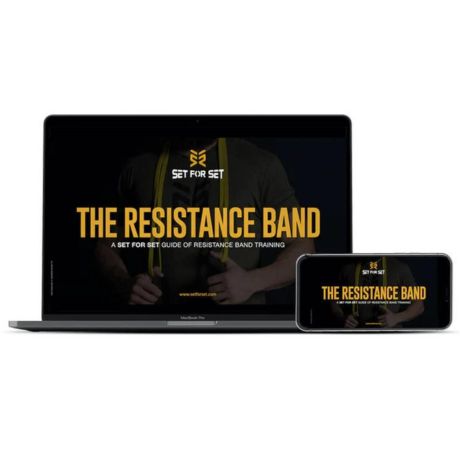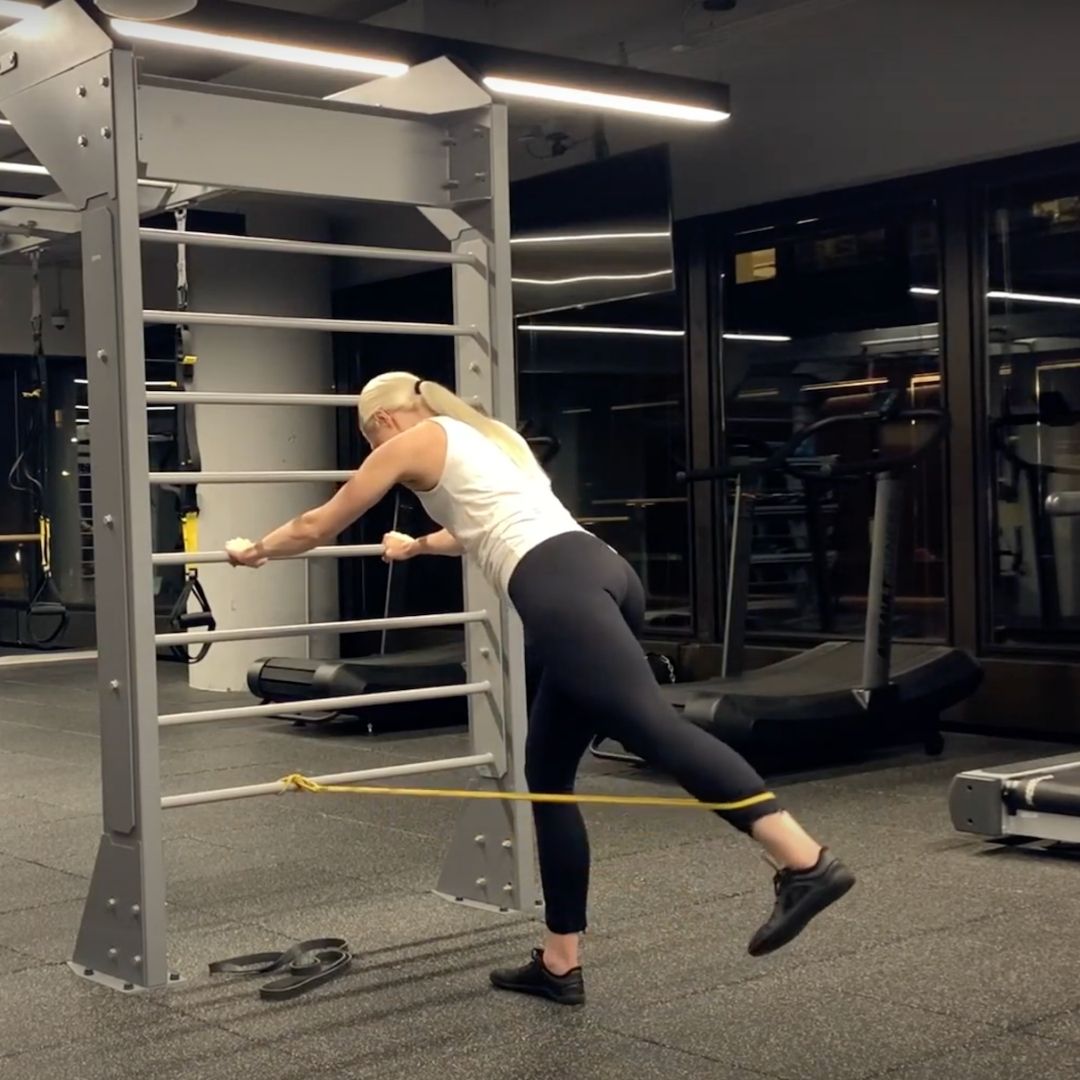When it comes to the glutes, there are several ways to go about training. The beauty of the butt is that it is one of the strongest parts of your body, and you use it every day. As such, it should be trained hard. Traditionally, you can work out your glutes with typical weight training exercises like squats and lunges. However, they likely need some additional attention for the best possible development. Using resistance bands can help you isolate your glutes effectively and conveniently. The banded glute kickback is the perfect example of this. It is a great way to isolate your glutes and give both cheeks the attention they deserve!

Take Your Fitness To The Next Level
What are Glute Kickbacks?
So, what are glute kickbacks? Well, there is actually a variety of different types of glute kickbacks, but for the sake of this article, we are talking specifically about straight leg hip extensions (bringing your leg back behind you).
With resistance bands, you can add resistance to virtually any body motion and exercise. This is exactly what we've done with the glute kickback, hence the name banded glute kickback. With the bands added, you get constant resistance throughout the entire motion.
The key function for the banded glute kickback exercise is at your hips. The hips are the only joint moving in this exercise (single joint exercise), and this is done by moving your leg backward.
So, you'll loop the band around a sturdy external object like a pole, then loop the other end around your lower leg, face the anchor point of the band and perform hip extension (bringing your leg back behind you while keeping your leg straight or with just a slight bend in the knee). You can see how this is done in the picture above.
How To Do Glute Kickbacks with Resistance Bands
You don’t need much for this exercise, but you do need something solid to attach the band too. If you are home, try a bed frame or a dining table.
How to do Banded Glute Kickbacks:
- Loop the preferred resistance band around a low anchor point.
- Loop the band around your leg. The lower it is on your leg, the more difficult it is. You want to keep the band below the knee and at or above the ankle. Right below your calf would be ideal.
- Slightly bend at the waist, and grip something for balance (i.e. put a chair to the side of you).
- Put a slight bend in the leg that stays on the ground, and extend the working side straight backward in a sweeping motion. It’s okay to have a slight bend in the knee.
- Pause and squeeze at the top.
- Return your leg back to the starting position, then repeat for desired repetitions.
- Switch legs and complete on the other side.
Angled Glute Kickbacks: If you want to add some variation, kickback at an angle outward. The angle incorporates more of your hip abductors (gluteus medius, gluteus minimus, and TFL), opposed to the pure hip extension that traditional kickbacks do. Your hip abductors are just another muscle in a long line of muscles that tend to get neglected. In charge of your support balance and alignment, it’s worth it to take the time to train them when you get the chance.
You can see how angled glute kickbacks are done in the video above too.
Common Form Mistakes
Nobody does something for the very first time at a hundred percent. It will take time to learn how to really hammer the glutes with kickbacks.
To help speed up the learning process, avoid these common mistakes to ensure you get the best out of your workout:
- Don’t straight-leg it: For the sake of balance and muscle movement, add a little flex to your legs.
- Don’t go too heavy: As said before, this is more aerobic than anaerobic.
- Don't stand straight up: It will be easier to target the muscles and get a greater range of motion if you lean forward a bit. This will also be easier on the lower back.
- Don't do speed reps: Move slowly on the eccentric phase (downward) and really focus on squeezing on the concentric phase (up/backward).
- Don’t short yourself: Do the exercise without the bands first to get an understanding of what a full rep should look and feel like. Some will get a slight pull on the band and reset without getting the full motion of the exercise.
A mirror is really helpful in this situation because it will show you just how good or bad your form is.

Our guide has over 250 exercises categorized by mobility, mobilization, resistance training, barbell training, explosive training, static stretching, and (p)rehabilitation...
Best Glute Kickback Alternatives:
Glute isolation is not limited to just one exercise. It’s good to learn a variety of exercises to help you target your glutes and the surrounding muscles.
1. Donkey Kick with Band

Donkey kicks involve knee flexion/extension, whereas glute kickbacks, like the feature of this article, are purely hip extensions. This makes it a multi-joint exercise, also bringing the quadriceps into play, but it is still mainly targeting the glutes.
How to do Donkey Kicks with Band:
- With the resistance band attached to a low anchor point, position yourself on your hands and knees.
- With your head towards the anchor point, place the resistance band on the arch of your foot.
- With shoulders square and back straight, kick out fully, extending your leg until its parallel with the floor.
- Slowly, in a controlled motion, return your leg back to the starting position.
- Repeat for desired reps and switch to the other side.
2. Lateral Band Walks

Lateral band walks target your hip abductors, which includes your glutes (mainly the two smaller gluteal muscles - the gluteus medius and minimus). It’s a great and simple way to improve hip stability and strength.
How to do Lateral Band Walks:
- Standing shoulder-width apart, stand within the loop of the band.
- Pull the slack of the band towards your chest and twist to create more resistance resistance.
- Sink your hips down, and shuffle your feet laterally. If you are limited on space, take one or two steps back and forth.
Note: Usually you'll see this exercise being done with the hip circle bands. This just shows you they can also be done with 41 inch loop resistance bands.
3. Banded Hip Abduction

This is another hip abductor exercise that involves anchoring the band. You've definitely seen these being done with a cable machine. The band replicates this movement.
How to do Banded Hip Abduction:
- With the resistance band attached to a low anchor point, stand parallel to the band and loop your outside leg into it.
- Keeping your abs engaged, lift your foot slightly off the ground and extend your leg outward to a 45-degree angle.
- Slowly, in a controlled manner, return to the starting position and repeat for desired repetitions.
- Continue on the other side.
Overall, these are great isolation exercises for the gluteal muscles. Add them into your leg workouts to give your gluteus the attention and additional volume they need to grow and get stronger.

The SFS FIVE Resistance Band Workout Package has 5 fun and challenging full length workouts using only resistance bands. Each workout targets different muscle groups. Together, the 5 workouts make for the perfect weekly workout routine.
What Size Band for Glute Kickbacks:
These glute kickbacks mimic that of a cable machine. We use 41 inch loop resistance bands, which vary in width from 0.5-2.5 inches (the width determines the resistance level).
We prefer these bands over fabric hip bands as they allow for greater range of motion. Plus, they are more versatile for other aspects of training, which is why they can be found in every gym.
If you don't have 41 inch loop bands, you should get them because they really can be used in so many ways. If you workout at the gym, see if your gym has them laying around and then try out some banded glute kickbacks!
In terms of resistance, you’ll find that kickbacks are more difficult than you think. Don’t expect to be pulling 100-pound bands; instead, expect somewhere in the range of 10 to 35 pound yellow band (0.5 inch wide). Don’t expect you to go any higher than the 30 to 60 pound black band (0.85 inch wide) for glute kickbacks.

Thanks to the flexibility of these bands, they really conform to you. It's easy to set up and you can control the resistance - the more you stretch, the more tension there will be, so if you start further away from the anchor point, it will be harder.
Are Glute Kickbacks with Bands Really Effective for Glutes?
Kickbacks are used to isolate and target your glutes (the name really says it all), but they will also work your hamstrings.
The mechanical function of this muscle group makes it difficult to target if you lack the knowledge for it. More often than not, your legs are meant to be pushing out, not pulling in. So, unfortunately (and possibly subconsciously), a lot of people tend to neglect their hamstrings.
Kickbacks are great because the movement does feel natural. After all, you do perform hip extension like this every time you walk or run.
You’ll see a lot of leaner athletes use this exercise to target their glutes, for additional volume and isolation after bigger compound movements like squats, lunges, and deadlifts.
Reps are the main focus here. The prolonged stress on your muscles will help develop lean muscle and help burn fat. You might actually find that you favor it over any other glute exercise.
If you do glute kickbacks with bands regularly, you will build stronger, tighter glutes and you will be able to run faster, jump higher, and move your lower body with more force.
Note: This is a great accessory exercise, meaning it should be done in addition to bigger compound movements. If used in this way, it will help you to really fill in the gaps of what the big compound movements miss. Oftentimes, big compound exercises like squats don't hit the glutes enough for full development, so exercises like glute kickbacks can help finish the job.
What Muscles do Banded Glute Kickbacks work?

The complexity of our body requires an individual muscle for literally every mechanical function. Something as simple as closing your hands or wiggling your toes uses a muscle. When it comes to walking, which straight leg hip extension (aka glute kickbacks) mimic, your glutes and hamstrings are the primary movers.
As such, banded glute kickbacks hold both the glutes and hamstrings accountable to make the movement happen.
Note: Your glutes are made up of three muscles - gluteus maximus, gluteus medius, and gluteus minimus; and the hamstrings are made up of three muscles, which you can learn more about here.
Towards the starting position, during the initial movement, you’ll be activating your hamstrings, but at full extension, your glutes (particularly the gluteus maximus) will be called to lockout and hold the pose. Make sure to take a pause at full extension to really squeeze your glutes.
Your other gluteal muscles (gluteus medius and minimus - aka the side glutes) will also be working on the opposite leg, which is planted, as to provide hip stability throughout the exercise.
FINAL NOTE:
Take advantage of your body’s own natural movements, and incorporate a resistance band into your daily routine. You might find that banded glute kickbacks are your new favorite glute exercise!
Related: 11 Variations of Glute Kickbacks with Cables, Bands & Bodyweight
Band Exercises:
- Banded Leg Curls
- Banded Good Mornings
- Resistance Band Lunges
- Resistance Band Deadlifts
- Resistance Band Squats
- Resistance Band Rows
- Resistance Band Back Exercises
- Resistance Band Chest Exercises
- Resistance Band Shoulder Exercises
- Resistance Band Triceps Exercises
- Resistance Band Biceps Exercises
- Resistance Band Core Exercises






0 comments